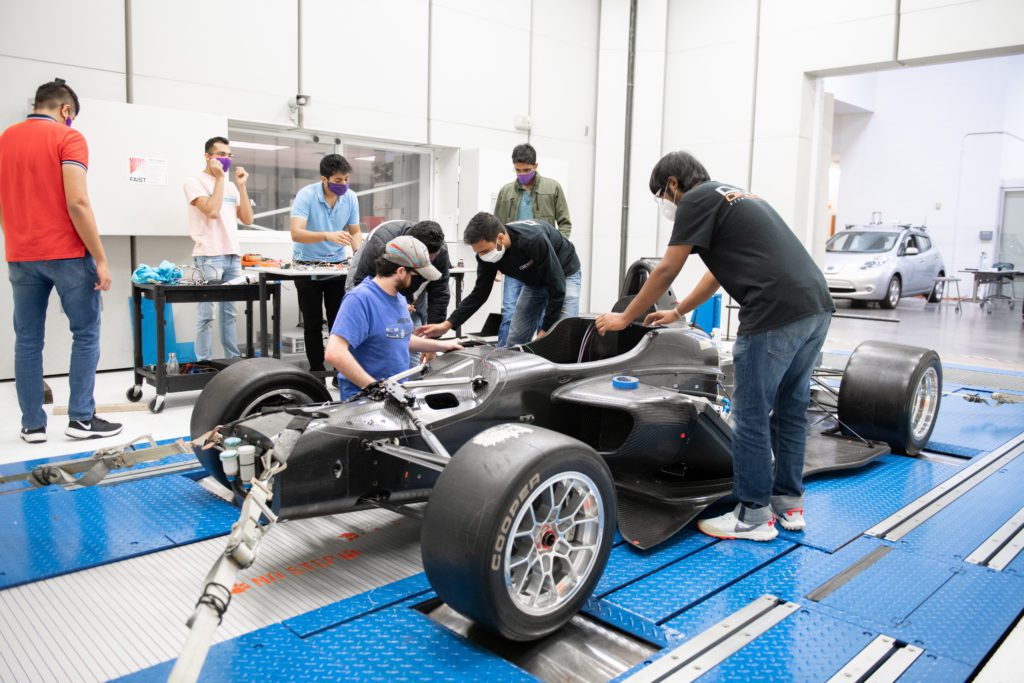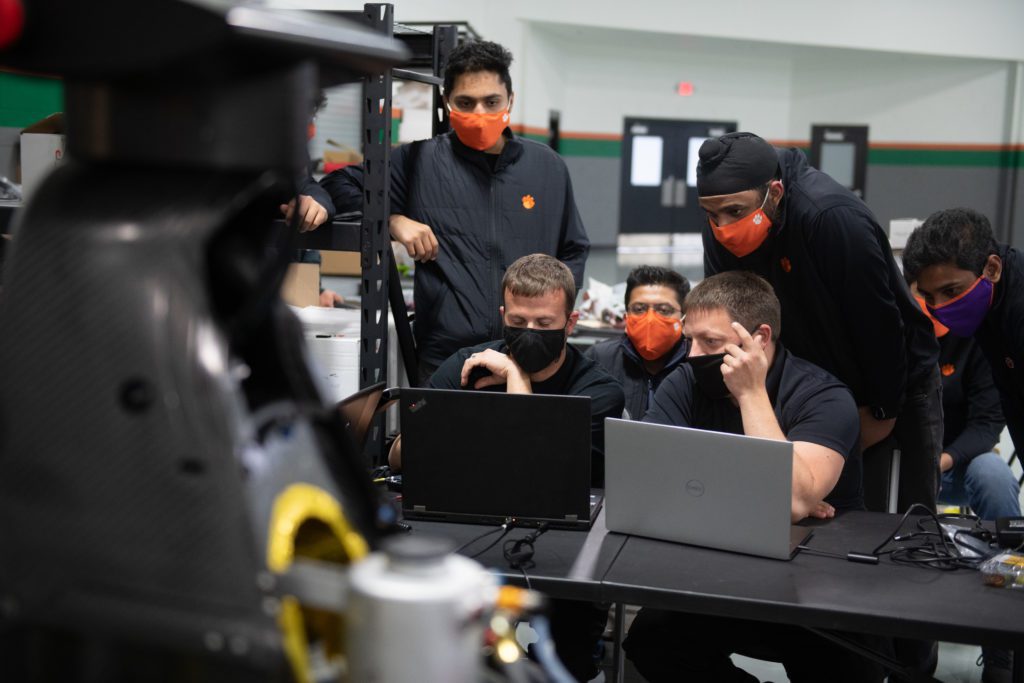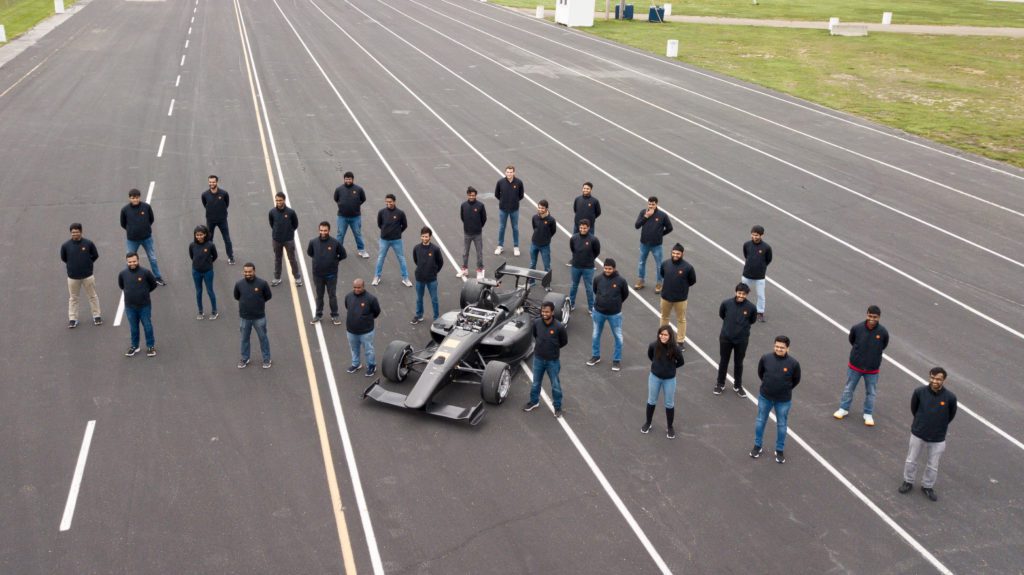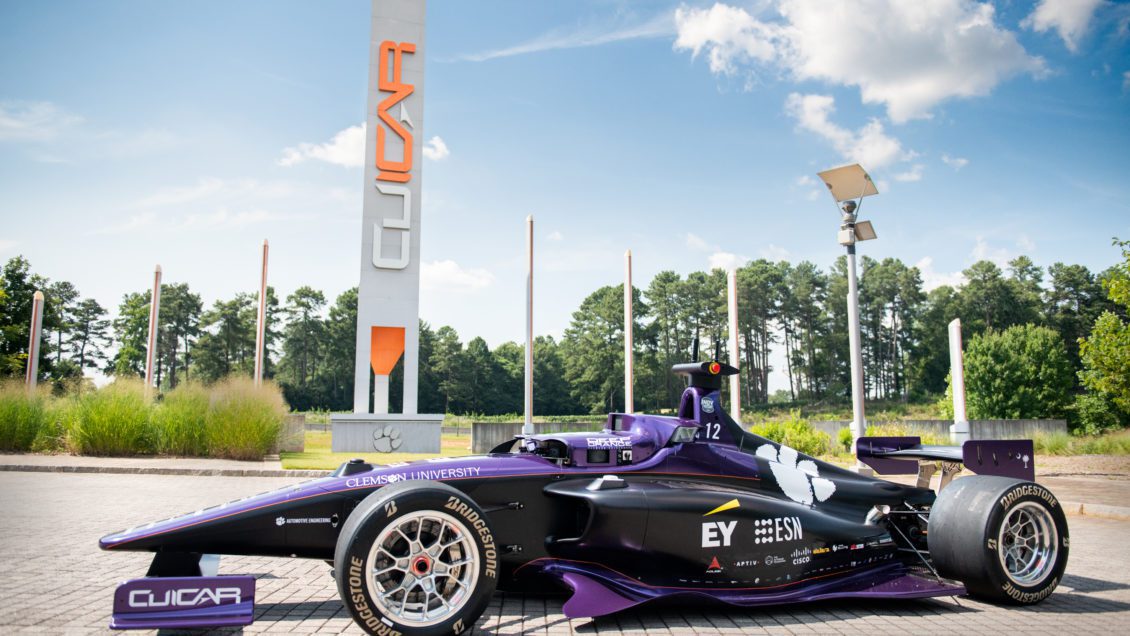Bundled in bulky jackets and scarves, a small group of Clemson students braced against the wind on a blustery Indiana day in March while walking on one of the world’s most famous race tracks.
Two months later, 135,000 fans would flood the same spot to watch the world’s best drivers hurtle past at 200 miles per hour. Today, however, the famous Indianapolis Motor Speedway was eerily quiet. The only sound came from the 20 students and faculty in the middle of the track, all working on a lone SUV armored in sensors, cameras and complicated computer systems.
“It was bit surreal we were even there,” said Unmesh Patil, a powertrain controls engineer on Clemson’s Deep Orange 12 student team. “A lot of us chose automotive engineering because we wanted to work in motorsports. This is the dream.”
These students were doing something very few people would ever have the chance to do: Testing their designs at the largest sports venue in the world. The day’s testing was just one more step towards their goal: engineering and validating a first-of-its-kind high-speed autonomous race car.
The 40-student team unveiled their finished self-driving racecar in Indianapolis this past May, wrapping up a whirlwind 18-month design cycle resulting in one of the most advanced self-driving projects ever attempted. Later this year, the Clemson car will be duplicated around a dozen times for use in a head-to-head autonomous race — making it one of the first university-designed vehicles to go into series production.
The Grand Challenge

In 2018, a small group of industry leaders, educators and economic developers gathered in Indianapolis to discuss a crazy idea: Putting on the first-ever head-to-head autonomous vehicle race, and run by students to boot.
“They outlined a vision, and we knew Deep Orange was the missing piece,” said Robert Prucka, Deep Orange 12 faculty lead and Kulwicki Endowed Professor in Motorsports Engineering and associate professor with the Clemson University Department of Automotive Engineering. “Here at Clemson, our expertise is engineering prototype cars with students. It was a natural fit for us to take this on.”
Every year, a team of Clemson automotive engineering students is tasked with designing a prototype vehicle to answer a grand challenge. Known as Deep Orange, the long-running program has brought in major OEMs and global suppliers to guide students through the harrowing vehicle design process. This year, however, it was different: Not only did students have to design cutting-edge autonomous systems, but their prototype had to operate at high speeds, follow complicated race control procedures and fit into a tightly-constrained, aerodynamic package.
From traditional OEMs and technology giants to well-funded startups, self-driving technology is transforming the mobility in the race for safety improvements and untapped business opportunities. Companies are pouring billions into R&D efforts, hiring armies of specialized engineers and logging millions of road miles. Challenges abound for applying autonomy to street vehicles, from handling unpredictable road hazards to cybersecurity and legal hurdles.
Autonomy in head-to-head racing goes one step further, pushing the limits of available technology to achieve sufficient speed, synchronicity, reliability and redundancy.
At 180 mph, Clemson’s racecar covers the length of a football field in 1.2 seconds. The sensor suite — including cameras, radars, long-distance LiDARs and high-precision GPS sensors — collects data so fast it can fill up a 1TB hard drive in 20 minutes. For scale, the Hubble Space Telescope generates 10TB per year, according to NASA. This puts a tremendous burden on the perception and computing systems to quickly, reliably and synchronously control the car at speeds much higher than typical consumer vehicles.
On top of those challenges, Clemson was tasked with making sure the vehicle could be produced multiple times in a cost effective and timely manner. This is far beyond previous Deep Orange projects, said Prucka.
“It’s an incredibly ambitious challenge, not just in the technology itself but with the short timeline, series production, disparate systems, and of course, staying safe during COVID,” said Prucka. “We ended up far exceeding our scope just due to the unprecedented nature of the project, of the grand challenge. We simply couldn’t know everything that would be required from the start.”
The Journey

So how do you engineer a first-ever autonomous racecar? The first challenge is building the team, says Janam Sanghavi, Deep Orange 12 Program Manager (’21). Previous Deep Orange projects divided students into traditional subsystems, but that same structure didn’t make sense for the Deep Orange 12 scope. One team strategy came down to making a plan for each of the primary controls they needed to design: steering, braking, gear shifting and throttle.
“We thought of making cross-functional teams around those problems, where people from each subsystem team came together to focus only on that control,” said Sanghavi. “I’m very proud of that, especially since it worked.”
The next challenge was determining the design envelope based on customer requirements. Similar to the OEM design process for consumer-focused vehicles, previous Deep Orange teams built out 3-4 personas to guide their designs. For Deep Orange 12, the customer was harder to define. In one sense, it was the competition teams developing autonomous algorithms ahead of a head-to-head race in October. In another, it was the partners responsible for reproducing the racecar, dictating that it be easily and cost effectively manufactured. In yet another, it was Clemson University aiming to provide unparalleled educational experiences and develop high-impact automotive engineering leaders.
Deep Orange 12 collaborated with more than 38 suppliers, partners and organizations over the project’s 12-month timeline, often co-creating brand new engineering solutions, components, software and capabilities tailored to the Clemson project. Such collaboration is critical to innovation, not only to find the best solutions but to ensure timely and cost-effective manufacturability. An inexpensive part that took six months to arrive, or a component requiring frequent or costly maintenance, were no-go solutions. Their choices determined the final bill of materials, production schedule and supply chain plan, all of which passed to the partners responsible for series production.
From there, it was all hands on deck to get things to work, said Akshay Palakkal, a controls integration engineer on the project.
“Because of COVID, a lot of our roles got shuffled around. You did what needed to be done regardless of your title. Even though I’m on the powertrain team, we made wiring harnesses, designed 3D models, anything that needed to be done because our deadlines were so aggressive,” he said. “One major challenge was working remotely. My old manager used to say, ‘You can’t build a car behind a computer.’ I never used to believe that, but now I see how it slows down everything. A 10-minute in-person brainstorming session is more valuable than five Zoom meetings.”
In March, students headed to Indianapolis to collect data using a surrogate vehicle, one outfitted with identical cameras, radars, long-distance LiDARs and high-precision GPS sensors as the final design. The project’s final milestones followed soon after, starting with the first engine fire and proof-of-concept of the autonomous systems and finally, a fully autonomous lap on the track.
“We’re excited, exhausted, worried, stressed out. Over the last year and a half, our subsystem teams have gone days in the lab trying to meet deadlines, to get the car ready, to get systems to work,” said Shristy Sagar, Deep Orange 12 Vehicle Structures Lead. “It’s incredible to see our first car drive by, to be followed by many more, and know we designed them. It’s probably the proudest moment of our lives.”
The Engineering Leaders of the Future

A crucial component of Deep Orange is how students work closely with industry leaders, developing the soft skills and project management prowess to launch their careers. As students attempt one of the most challenging programs of its kind, mentors guide them to avoid common pitfalls, develop interpersonal skills and ingrain best practices to help them after graduation.
A month after graduation, more than 95% of the Deep Orange 12 team have found roles in industry, some with traditional OEMs and others at high-profile mobility startups and technology companies.
“We say it all the time, but the ideal outcome of Deep Orange is highly capable students,” said Chris Paredis. “This was an incredibly challenging project, but if our experience tells us anything, it’s that these learning experiences have a tremendous impact on their success after they leave Clemson.”
The student team presented their final design in May, sharing it with their colleagues, their mentors and most importantly, their parents.
“This experience is so unique. Most autonomous projects in motorsports are confined to 1/10th scale cars, or working on specific subsystems. Most of us don’t get to work on something like this, something that has never been done,” said Unmesh Patil, a powertrain controls engineer on the project. “Without parental support, I think this project would be impossible to do. We got to share it with our families, I shared it with my mother during our final presentation. We don’t usually get to discuss these things in that much detail, and I was very excited to share that with her.”
“It’s been a huge learning curve, a lot of changes and how we’ve adapted and made things possible, it’s quite a feat that the entire team has pulled together. Autonomy is in the budding stages, and as students we are learning and applying things, so there’s s a lot of experimentation where we continuously try things and find ways to do it. That’s where engineering shines,” said Manikanda Balaji Venkatesan, Deep Orange 12 Autonomy Lead. “I’m elated. The fact that we were able to pull this off, and exceed what we wanted to do, is just amazing.”
Under the Hood of Deep Orange 12
The Deep Orange 12 vehicle was engineered around five primary goals: Engineer an autonomous racecar, within an existing professional-level open-wheel racing chassis, to reach up to 180 mph, to be easily and cost-effectively manufacturable, that prioritizes safety. Read more about how students achieved those goals through these unique selling propositions (USPs):
- Advanced Perception Systems: Students integrated a robust suite of cameras, radars, long-distance LiDARs, and centimeter-accuracy GPS sensors to observe, process and make decisions to control the car safely at racing speeds.
- Precision High-speed Drive-by-wire Control: In a drive-by-wire vehicle, losing power means losing control. Students engineered electrically powered steering, braking, throttle and shifting controls with backup systems and redundant safety checks
- Low-Latency, High-Throughput, Ultra-Reliable V2X Communication: Students integrated a wireless communication system that can send telemetry data such as vehicle speed, engine RPM, or tire temperatures, as well as autonomy data such as video, and localization information in real-time without data loss .
- Purpose-Built Structural Racing Engine: Unlike street vehicles, the compact and lightweight packaging of Indy racecars required Clemson to design a complex engine packaging system to withstand the stresses of high-speed driving while meeting the needs of autonomous racing.
- Lightning-fast On-Board Computing and Software: High-speed racing requires high-speed decision-making and controls. Students integrated a ruggedized computer specifically configured for autonomy to deliver crucial information to the competition teams.
- Designed for Series Production: Students orchestrated full manufacturing plans to ensure their design could be duplicated quickly, efficiently, within budget and with easy-to obtain components. Clemson’s autonomous racecar represents the University’s first-ever vehicle to go into series production.
- Rules and Procedures for Head-to-Head Autonomous Racing: To enable multi-vehicle, head-to-head autonomous racing in the spirit of both traditional racing and this competition, students wrote the rule book to dictate how vehicles must safely behave when on the racetrack.
- Ultra-Compact Aerodynamic Component Packaging: At 180 mph, aerodynamics matter. Students fit all their complex systems into the space normally occupied by the driver, while preserving the aerodynamic efficiency and integrity of the ultra-lightweight chassis.
- Unparalleled Systems Integration Education: Over 18 months, during a pandemic, the Clemson students honed both their hard and soft skills by collaborating with more than 38 global partners to deliver a first-of-its-kind autonomous racecar capable of high-speed racing.
Get in touch and we will connect you with the author or another expert.
Or email us at news@clemson.edu

